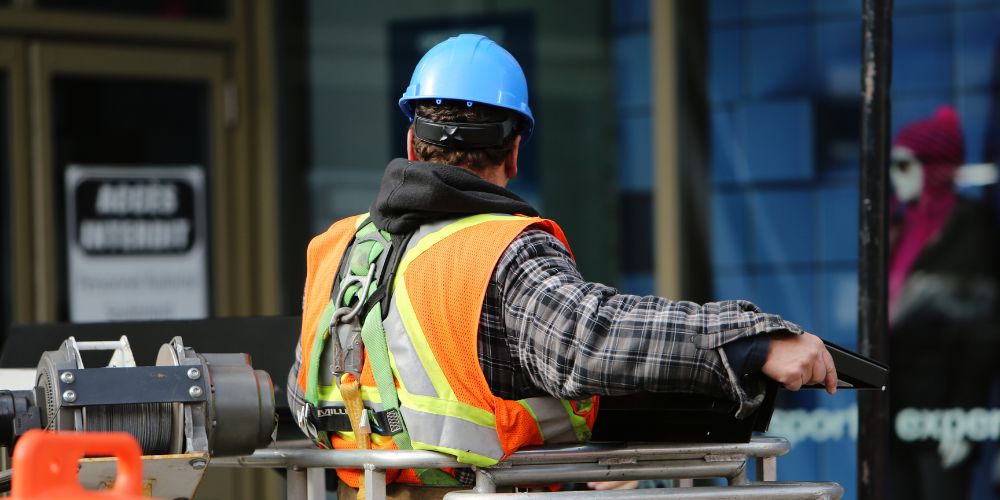In construction sites, hazards are abundant and workers face direct exposure to them. Thereby, high-visibility construction vests are a crucial component of a comprehensive safety strategy in the industry. The construction vests enhance safety, increase productivity, and ensure regulatory compliance on construction sites, thereby creating a safer and more efficient work environment. This article will introduce the top 6 benefits of wearing safety vests on construction sites, highlighting how they enhance visibility and improve team coordination and efficiency.
Enhancing Visibility
The primary role of high-visibility construction vests is to make workers more visible, significantly reducing the risk of accidents and injuries. These vests are designed with vibrant fluorescent colors like yellow-green or orange, which stand out in various lighting conditions and from significant distances. The vests also include retroreflective materials, enhancing visibility even further, and allowing workers to be clearly seen from all directions and from distances up to 500 feet.
The construction vests ensure that workers are visible and identifiable, providing essential protection against accidents. This is particularly crucial in situations involving construction, heavy machinery, and adverse weather conditions. In environments where movement is continuous or visibility is compromised by weather such as fog, rain, or snow, the reflective and fluorescent properties of the vests could save lives.

Compliance with Safety Regulations
High-visibility safety vests are not just practical—they are also a legal requirement in many construction settings, especially those that involve traffic or the operation of heavy machinery. The Occupational Safety and Health Administration (OSHA) mandates that workers exposed to these hazards wear appropriate high-visibility safety apparel. This regulation helps prevent 'struck-by' accidents, which are among the leading causes of fatalities in construction.
The American National Standards Institute (ANSI) mandates that these vests feature a significant amount of reflective material and are in bright, conspicuous colors to maximize visibility against any background. Additionally, the ANSI defines specific requirements for these vests, classifying them into three visibility classes depending on the workplace's risk level.
- Class 1: Offers minimal visibility and is suited for areas where traffic does not exceed 25 mph.
- Class 2: Required for workers who are near traffic exceeding 25 mph or where tasks divert attention from approaching traffic.
- Class 3: Provides the highest level of visibility and is necessary for workers in extremely dangerous environments where traffic exceeds 50 mph or in poor visibility conditions.
Mitigating Work-Related Injuries
High visibility is essential for the safety of construction workers, particularly in environments where heavy machinery and vehicular traffic are present. The use of fluorescent materials and reflective strips makes workers conspicuous in different lighting conditions, thus preventing accidents and injuries.
Beyond enhancing visibility, some construction vests also provide protection against certain types of job-related injuries. Fire-resistant vests incorporate self-extinguishing materials, providing extra protection against heat and flames, while anti-static vests are equipped with insulating material to guard against electric hazards, both of which are common in construction environments.

Optimizing Tool Access and Workflow
The practical design of high-visibility safety vests includes features that optimize the accessibility of tools and equipment, thereby enhancing productivity on the construction job site. Construction vests often feature multiple pockets designed to hold a variety of tools and devices—from pens and notepads to smartphones and small hand tools. Certain vests are tailored with dedicated pockets for radios, ID badges, and other essential equipment, allowing for easy access and secure storage.
Additionally, some safety vests are equipped with specialized loops and hangers for carrying larger tools like hammers, tape measures, and water bottles. These design features help keep construction workers hands-free and reduce the time spent retrieving tools, thus saving time and boosting efficiency on the job.
Enhancing Brand Identity and Professional Appearance
Beyond their functional benefits, high-visibility construction vests also act as a potent tool for branding and enhancing the professional appearance on construction sites. Custom safety vests are embellished with company logos, turning workers into mobile representatives of the company brand.
The consistent use of branded safety vests contributes to a cohesive and professional appearance that projects organization and discipline. Such an environment is reassuring to clients and site visitors, underscoring the company’s dedication to work and professional standards.
Facilitating Team Coordination and Operational Efficiency
The clear visibility provided by construction vests facilitates effective communication across the construction site. Workers can easily see and interact with each other over distances or in noisy settings, supporting swift decision-making and coordination. This enhances work efficiency and helps prevent accidents.
The ability to swiftly identify team members is also critical for efficient communication and decision-making. Safety vests differentiated by color or marked with specific symbols allow for quick recognition of individuals' roles and group affiliations, facilitating rapid coordination.

Conclusion
The widespread adoption of high-visibility safety vests in construction highlights their importance to this industry. These garments go beyond their basic function of enhancing visibility; they are integral to a comprehensive safety strategy that promotes a secure and efficient work environment. As the construction industry progresses, the role of high-visibility construction vests will undoubtedly continue to expand, affirming their status as an essential element of a modern, responsible, and well-managed construction site.
Frequently Asked Questions (FAQs)
Why is it important for construction workers to wear high-visibility safety vests?
Wearing high-visibility safety vests is crucial for construction workers to enhance their visibility, reducing the risk of accidents involving vehicles or machinery, especially in low-light conditions or areas where workers might be obscured by equipment or environmental factors.
Are there specific standards regulating the use of high-visibility safety vests?
Yes, high-visibility safety vests must comply with standards such as the ANSI/ISEA 107 in the United States, which specify requirements for the design and materials to ensure adequate visibility and safety for workers in different environments.
Can safety vests be customized for different construction roles?
Yes, safety vests can be customized with various features like different numbers of pockets, specific colors for different job roles, and company logos to enhance organizational identity and ensure specific functional requirements are met for different workers on the site.





